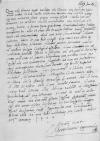 UUB, H. 154, f. 15r
UUB, H. 154, f. 15r
Quam mihi fuerint gratae cf. Ioannes DANTISCUS to Maximiliaan van EGMOND-BUREN before 1529-01-17, CIDTC IDL 6519, letter lost⌊tuae litteraecf. Ioannes DANTISCUS to Maximiliaan van EGMOND-BUREN before 1529-01-17, CIDTC IDL 6519, letter lost⌋, Vir Clarissime, non facile persuasero, nempe quibus de tua recta valetudine certior sum factus, quam ego non minoris facio quam meam ipsius. Nulla haec est temeritas ut scribis, nulla confidentia, scis enim, quo animo quamque sincere a prima hora, qua tecum consuetudinem inibam, amaverim te. Adeo, ut quas abs te accepi litteras, tamquam perpetuum tanti viri mnemosinon apud me sum servaturus. Faxint interim superi, ut
cf. Ov. Rem. 390 Maius erit, tantum quo pede coepit, eat.; Ov. Pont. III 4. 87 Quo pede nunc utar, dubia est sententia nobis ⌊quo pede coepisticf. Ov. Rem. 390 Maius erit, tantum quo pede coepit, eat.; Ov. Pont. III 4. 87 Quo pede nunc utar, dubia est sententia nobis ⌋
sive maris, sive terra in tam sepositam Poland (Kingdom of Poland, Polonia)⌊PoloniamPoland (Kingdom of Poland, Polonia)⌋ felicibus avibus pervenias. Quod si ad nostros The Belgians ⌊BelgasThe Belgians ⌋ contigerit appellere, cave committas, oro, ut insalutato Floris van Egmond-Buren (*1469 – †1539), Dutch nobleman, administrator and army leader in the service of the dukes of Burgundy and the Habsburgs; 1505 Knight of the Golden Fleece; 1493 Chamberlain of Philips of Habsburg, 1506 member of the Court Council of Margaret of Austria, 1510 Stadtholder of Guelders in the territories under Habsburg control, 1511-1515 substitute-Stadtholder of Holland and Zeeland beside his uncle, Stadtholder Jan III van Egmond, 1513 chamberlain of Charles V, 1515-1517 Stadtholder of Friesland, 1531-1539 member of the Council of State; from the late 15th century leadingmilitary campaigns mainly against Guelders, 1536 Captain-General of the army in the Northern parts of the Habsburg Netherlands; Count of Buren and Leerdam, Lord of Ijsselstein e.a. (DE VOCHT 1961, p. 43, 73, 317; CE, vol. 1, p. 421-422)⌊parenteFloris van Egmond-Buren (*1469 – †1539), Dutch nobleman, administrator and army leader in the service of the dukes of Burgundy and the Habsburgs; 1505 Knight of the Golden Fleece; 1493 Chamberlain of Philips of Habsburg, 1506 member of the Court Council of Margaret of Austria, 1510 Stadtholder of Guelders in the territories under Habsburg control, 1511-1515 substitute-Stadtholder of Holland and Zeeland beside his uncle, Stadtholder Jan III van Egmond, 1513 chamberlain of Charles V, 1515-1517 Stadtholder of Friesland, 1531-1539 member of the Council of State; from the late 15th century leadingmilitary campaigns mainly against Guelders, 1536 Captain-General of the army in the Northern parts of the Habsburg Netherlands; Count of Buren and Leerdam, Lord of Ijsselstein e.a. (DE VOCHT 1961, p. 43, 73, 317; CE, vol. 1, p. 421-422)⌋ illinc te subripias. Nil est, quod ei dici velim, quam quod eam ei precor valetudinem, qua praeditus sum ego. Quod abs me summopere flagitasti, ut dum me praesente tui apud Charles V of Habsburg (*1500 – †1558), ruler of the Burgundian territories (1506-1555), King of Spain as Charles I (1516-1556), King of Naples and Sicily, King of the Romans (1519-1530), Holy Roman Emperor of the German Nation (elected 1519, crowned 1530, abdicated 1556); son of Philip I the Handsome and Joanna the Mad of Castile⌊imperatoremCharles V of Habsburg (*1500 – †1558), ruler of the Burgundian territories (1506-1555), King of Spain as Charles I (1516-1556), King of Naples and Sicily, King of the Romans (1519-1530), Holy Roman Emperor of the German Nation (elected 1519, crowned 1530, abdicated 1556); son of Philip I the Handsome and Joanna the Mad of Castile⌋ facta fuerit mentio, ego te illi perpetuo addictum pollicerer, feci hoc mane et libenter eam audivit salutationem. Magister curiae maior, Charles de Poupet of La Chaulx (of Lassau) (†1530), knight of Alcantara; member of the Imperial Council of Charles V; imperial envoy to England, Portugal and France⌊paterCharles de Poupet of La Chaulx (of Lassau) (†1530), knight of Alcantara; member of the Imperial Council of Charles V; imperial envoy to England, Portugal and France⌋ et filius de la Chaulx, marchio de Ancisa, dominus de Corrir et dominus de Pelon tibi cum multo foenore salutem, quam tuis litteris illis dederas, reddunt ac felicissimam precantur profectionem. Si quid sit, quod in aula Charles V of Habsburg (*1500 – †1558), ruler of the Burgundian territories (1506-1555), King of Spain as Charles I (1516-1556), King of Naples and Sicily, King of the Romans (1519-1530), Holy Roman Emperor of the German Nation (elected 1519, crowned 1530, abdicated 1556); son of Philip I the Handsome and Joanna the Mad of Castile⌊caesareae maiestatisCharles V of Habsburg (*1500 – †1558), ruler of the Burgundian territories (1506-1555), King of Spain as Charles I (1516-1556), King of Naples and Sicily, King of the Romans (1519-1530), Holy Roman Emperor of the German Nation (elected 1519, crowned 1530, abdicated 1556); son of Philip I the Handsome and Joanna the Mad of Castile⌋ me tuo nomine efficere iusseris, gratissimum feceris. Ego veri amici officio praesertim in tuo negotio fungar. Quod barbarius scripsi, ignorantiae meae condonabis. Bene vale ac me tibi addictum persuade.


 UUB, H. 154, f. 16v
UUB, H. 154, f. 16v